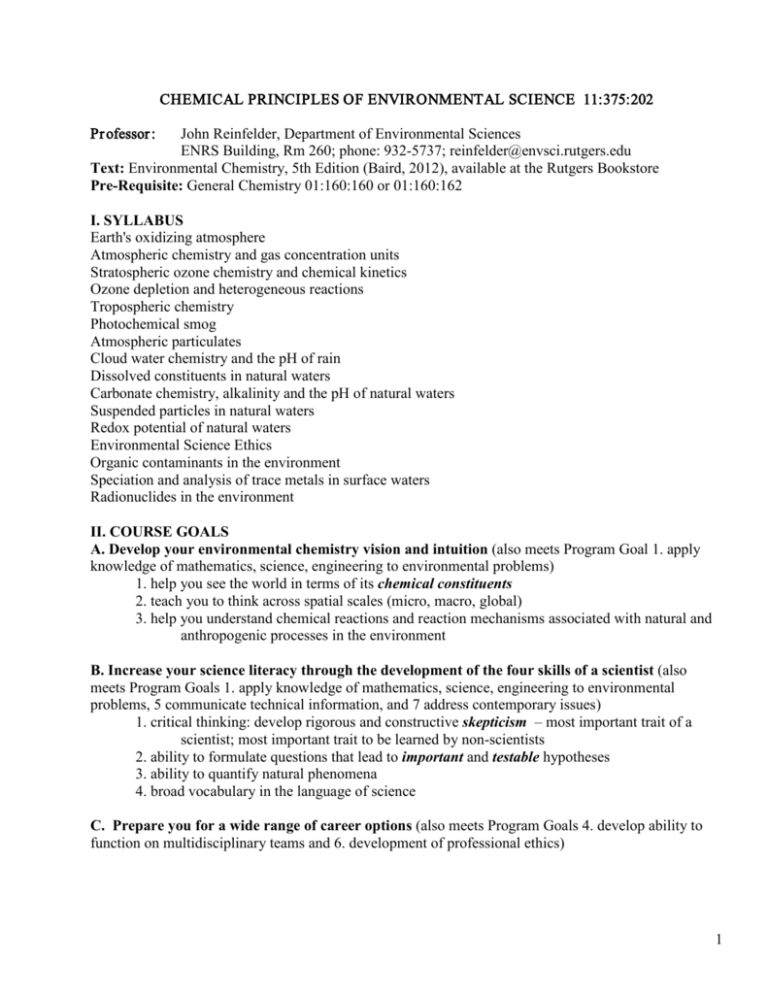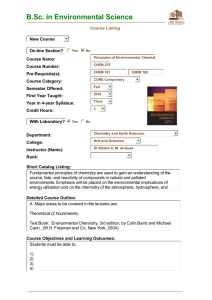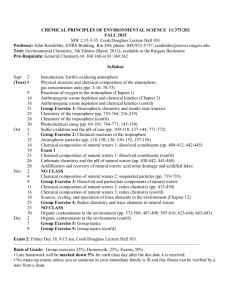chemical principles of environmental science
advertisement

CHEMICAL PRINCIPLES OF ENVIRONMENTAL SCIENCE 11:375:202 Pr ofessor : John Reinfelder, Department of Environmental Sciences ENRS Building, Rm 260; phone: 932-5737; reinfelder@envsci.rutgers.edu Text: Environmental Chemistry, 5th Edition (Baird, 2012), available at the Rutgers Bookstore Pre-Requisite: General Chemistry 01:160:160 or 01:160:162 I. SYLLABUS Earth's oxidizing atmosphere Atmospheric chemistry and gas concentration units Stratospheric ozone chemistry and chemical kinetics Ozone depletion and heterogeneous reactions Tropospheric chemistry Photochemical smog Atmospheric particulates Cloud water chemistry and the pH of rain Dissolved constituents in natural waters Carbonate chemistry, alkalinity and the pH of natural waters Suspended particles in natural waters Redox potential of natural waters Environmental Science Ethics Organic contaminants in the environment Speciation and analysis of trace metals in surface waters Radionuclides in the environment II. COURSE GOALS A. Develop your environmental chemistry vision and intuition (also meets Program Goal 1. apply knowledge of mathematics, science, engineering to environmental problems) 1. help you see the world in terms of its chemical constituents 2. teach you to think across spatial scales (micro, macro, global) 3. help you understand chemical reactions and reaction mechanisms associated with natural and anthropogenic processes in the environment B. Increase your science literacy through the development of the four skills of a scientist (also meets Program Goals 1. apply knowledge of mathematics, science, engineering to environmental problems, 5 communicate technical information, and 7 address contemporary issues) 1. critical thinking: develop rigorous and constructive skepticism – most important trait of a scientist; most important trait to be learned by non-scientists 2. ability to formulate questions that lead to important and testable hypotheses 3. ability to quantify natural phenomena 4. broad vocabulary in the language of science C. Prepare you for a wide range of career options (also meets Program Goals 4. develop ability to function on multidisciplinary teams and 6. development of professional ethics) 1 III. INSTRUCTIONAL ACTIVITIES TO ACHIEVE GOALS Goals A and B • applications of the chemical kinetics and thermodynamics of gas and aqueous phase reactions to past and current environmental problems are presented in course lectures and readings; • students apply these concepts by completing individual problem sets outside of class and during inclass cooperative group exercises. Goal C • groups of 4 to 6 students work cooperatively to solve environmental chemistry problems during inclass group exercises; • students are provided guidance on how to work effectively in groups prior to and during group exercises. • professional ethics are discussed in a unit and case study on environmental science ethics IV. ASSESSMENT ACTIVITIES Goals A and B • individual performance on take home problem sets (30% of assessment) • performance on group exercises (30% of assessment) • individual performance on three exams (40% of assessment) Goal C • evaluation of solutions to group exercises (90% of assessment) • response to environmental ethics case study (10% of assessment) 2








